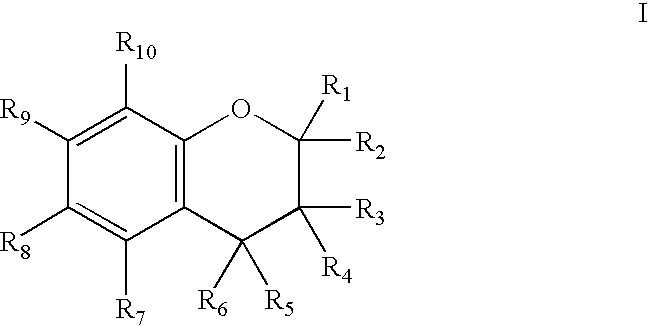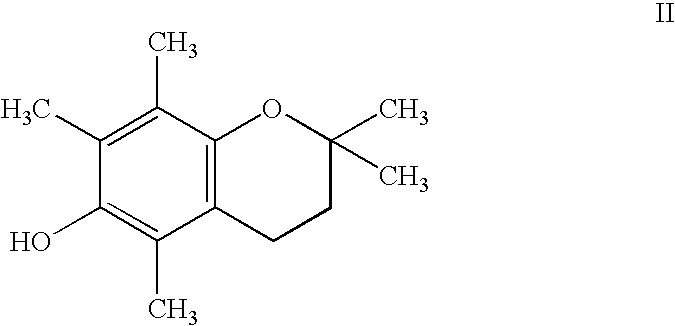Chroman-Derived Compounds For The Treatment Of Cancer
a technology of chroman and compounds, applied in the field of chroman-derived compounds for the treatment of cancer, can solve the problems of high risk of cancer, many complications or side effects, impotence and hot flashes, etc., and achieve the effect of preventing the occurrence or recurrence of prostate cancer and reducing the progression of prostate cancer
- Summary
- Abstract
- Description
- Claims
- Application Information
AI Technical Summary
Benefits of technology
Problems solved by technology
Method used
Image
Examples
example 1
Androgen Antagonist Activity by the Antioxidant Moiety of Vitamin E, 2,2,5,7,8-pentamethyl-6-chromanol, in Human Prostate Carcinoma Cells
A. Summary
[0098]The present inventors have shown that the antioxidant moiety of vitamin E, 2,2,5,7,8-pentamethyl-6-chromanol (PMCol), has anti-androgen activity in prostate carcinoma cells. In the presence of PMCol, the androgen-stimulated biphasic growth curve of LNCaP human prostate carcinoma cells was shifted to the right. The PMCol-induced growth shift was similar to that produced by treatment with the pure anti-androgen bicalutamide (i.e., Casodex), indicative of androgen receptor antagonist activity. The concentration of PMCol used was below the concentration required to affect cell growth or viability in the absence of androgen. Using an androgen receptor binding competition assay, PMCol was found to be a potent anti-androgen in both LNCaP and LAPC4 cells, with an IC50 of approximately 10 μM against 1 nM R1881 (a stable, synthetic androgen)....
example 2
Acute Oral Toxicity in Mice
[0124]The oral toxicity of PMCol was determined in 6 month-old male FVB mice. A single high oral dose of 1000 mg / kg PMCol in sesame oil was administered to 4 mice by gavage. Four control mice received only sesame oil by gavage (vehicle control). No significant change in animal behavior or body mass (FIG. 8A) occurred after administration of PMCol or vehicle control for up to 1 week after PMCol administration. In a second study, four 6 month-old male FVB mice received 200 mg / kg PMCol daily in sesame oil by gavage for 10 days. Three mice receiving only sesame oil (vehicle control) were used as controls. Body weights were determined daily and all mice were autopsied to examine gross organ changes on day 11. No significant difference in body mass change was observed in comparing PMCol-treated and vehicle control mice over 10 days (FIG. 8B). No gross changes in organs were observed for either PMCol-treated or control mice. For example, liver mass was not signif...
example 3
Determining In Vivo Efficacy of a Chroman-Derived Anti-Androgen Using the LNCaP Xenograft Model and the TRAMP Prostate Carcinogenesis Model
[0125]A nude mouse / LNCaP xenograft model, similar to the DU145 xenograft method previously described (Church et al., Cancer Chemother. Pharmacol. 43:198-204 (1999)), may be used to examine the in vivo actions of PMCol on human prostate carcinoma cell growth. Male Hsd: athymic nude-nu (nu / nu, BALB / c origin) mice at 4 weeks of age will be acquired from Harlan Sprague Dawley (Madison, Wis.). At 6 weeks of age, each mouse will be subcutaneously xenografted with 106 LNCaP cells in 0.1 mL of medium +0.1 mL of Matrigel (BD Biosciences) in flanking ventral fat pads. One week after LNCaP xenografting, mice will be divided into 5 treatment groups of 10 mice each. Mice in group 1 will receive a vehicle control of 0.25 mL of corn oil by gavage, group 2 will receive 25mg / kg of flutamide (Sigma Chemical Co., St. Louis, Mo.) as an anti-androgen treatment contro...
PUM
| Property | Measurement | Unit |
|---|---|---|
| structure | aaaaa | aaaaa |
| concentration | aaaaa | aaaaa |
| water soluble | aaaaa | aaaaa |
Abstract
Description
Claims
Application Information
 Login to View More
Login to View More - R&D Engineer
- R&D Manager
- IP Professional
- Industry Leading Data Capabilities
- Powerful AI technology
- Patent DNA Extraction
Browse by: Latest US Patents, China's latest patents, Technical Efficacy Thesaurus, Application Domain, Technology Topic, Popular Technical Reports.
© 2024 PatSnap. All rights reserved.Legal|Privacy policy|Modern Slavery Act Transparency Statement|Sitemap|About US| Contact US: help@patsnap.com










